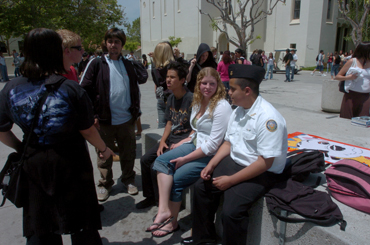
Mixed feelings aside, military on all local campuses
With fewer young people opting for military careers as the war
in Iraq drags on, armed forces recruiters are keeping a high
profile on local campuses.
Mixed feelings aside, military on all local campuses
With fewer young people opting for military careers as the war in Iraq drags on, armed forces recruiters are keeping a high profile on local campuses.
Recently a growing number of schools throughout the country have set limits pertaining to access granted to military recruiters, after parent complaints that recruiters were overzealous or on campus too often.
All local campuses remain open to recruiting efforts, access that’s required in order for school districts to receive federal funds under the No Child Left Behind Act.
High schools that get federal funds must allow military recruiters the same access as they do colleges. If recruiters are confined to tables in the counseling office, the same must apply to college representatives.
In 2002, a provision in the No Child Left Behind Act required schools to turn over the names, addresses and phone numbers of students to the military unless parents opted out.
Ann Sobrato High School does not currently have any seniors; so principal Richard Knapp said he was kind of surprised when he got his first request from a military recruiter to come onto campus last week.
Knapp said that he had not worked out the details yet, but that he suspects that the recruiter will have access to the students only through the career center.
He said when he was at Live Oak in Morgan Hill, recruiters were given space at the career center.
He declined say whether or not his personal feelings conflicted with allowing the recruiters on campus, but said that regardless of his feelings with the law written the way it is, the schools have to allow recruiters access.
“But we can have control over how that takes place,” Knapp said.
Anzar High School Principal Charlene McKowen didn’t hide her feelings about recruiters.
“Unfortunately we have to allow them access, because of the funding laws. But I control how they have access to the students,” McKowen said. “We allow them on the campus only if they have made an appointment well in advance and they can have a table up during lunch but only contact the students if the students approach them.”
She said that basically they treat the recruiters like a cross between a business offering summer jobs and a college recruiter.
“It’s an alternative that’s out there. We trust that our junior and senior students know how to think and will approach the military that way. It’s uncomfortable because we’re at war,” McKowen said.
The principal said she understands that recruiters have a job to do. However, she will not allow students to fill out applications on campus.
Students at Anzar High School are never taught just one side of any issue, McKowen said. They are taught how to think and to understand the balance in everything.
Gilroy High School Principal James Maxwell said that the high school allows recruiters all the same amenities they extend to colleges and summer employers, as long as they don’t cause a disturbance.
Depending on the day the recruiters will set up tables inside the career center or outside in the quad next to the college tables.
The names of students whose parents ask that they not be released are withheld, Maxwell said.
“We’ve had a few parents complain about recruiters being on campus, but they have a right to be here,” Maxwell said.
San Benito High School Superintendent Jean Burns Slater said that the district has a similar policy to Gilroy’s. The school informs parents at the start of every school year and gives them the choice before disclosing names, addresses and telephone numbers of secondary students to military recruiters. They do the same thing for college recruiters.
Access to names and phone numbers makes access to the students easier than in the past, because some schools previously refused to provide them made the military buy the information. But the change also had a downside. According to Associated Press in an article released earlier this month, those actions stirred up the nerves of some parents, who complained that schools did a poor job of publicizing the opt-out clause.
Over the past year, the controversy has helped fuel new recruiting limits at schools in Washington, Maine, Illinois and now Arizona. Limits including capping the number of visits to giving equal access to groups that promote alternatives to the military. Such groups included Coalition Against Militarism in Our Schools and militaryfreezone.com.
San Benito High School welcomes recruiters on their campus, said Jeanie Churchill, career and scholarship advisor. She said that the recruiters for the various branches of the military haven’t been around the campus as much recently, but they do regularly check in and maintain their kiosks in the career center building.
“If they get passes they can roam around campus, but usually they’re in here (career center) or outside occasionally and they’re always helping out with any classrooms that request a visitation,” Churchill said.
Students at San Benito reported regularly seeing military recruiters roaming around the high school.
“I’ve seen a lot of them roaming around campus, I think it’s okay because they’re promoting one option for the future,” said junior Damasio Zepeda. Still, he said he thinks it’s a little invasive. “It doesn’t really capture my attention.”
Sophomore Kelley King said she didn’t really agree with having recruiters on campus, since high school students, at this age, are too young to make important career decisions.
Not all the students had an opinion about recruiters on campus. Justin Duncan, sophomore, said he thought recruiters should do what they want and he didn’t think it was a big issue at all.
There is also a visibility factor at San Benito High School that other schools in the area don’t have, as Hollister has a Junior Reserve Officer Training Corps (JROTC) program on campus. Students wear uniforms once a week, and receive physical education credit for the class.
JROTC teacher, Retired Cdr. Dean Whetstine, doesn’t want people to view his JROTC program as a recruiting device. Whetstine – who is the senior Naval science instructor at San Benito High – said that during the JROTC program the staff does not make any pitches to the students. They do however talk about the Navy, since it’s the focus of the program and the beneficiary, but he said that the majority of students who are involved in JROTC are there more for the camaraderie than anything else. Other students see it as a way out of their PE requirement and there are those who are interested in getting a jump on military service.
Natalie Becker is a freshman in the JROTC program. She said that she would ultimately like to go into the military and will attempt to get into the Naval Academy at Annapolis; otherwise she’ll go directly into the Navy. She sees recruiters on campus, but it doesn’t bother her.
Becker said that she was approached while hanging out with a group of JROTC cadets.
“I think they’re good people,” Becker said.
Another freshman in the JROTC program, Nick McGill, said that his future goal is to be a pilot so he’s met with recruiters from the Navy and the Air Force, but also the other branches of the military as well.
“I think it’s a great idea having recruiters on campus,” McGill said.
“I am glad they don’t visit middle schools. Eighth grade I think is fine, but not the lower grades.”
Mass Communications Spec. 1st Class Craig Coleman, a public affairs officer with the Navy Recruiting District, San Francisco, said that access to the students often depends on the school. He could not speak specifically about San Benito or South Valley high schools, but said that usually the Navy asks for equal access to the students that other schools and vocations receive.
They also do cold calls to students, but if the students don’t show any interest, they don’t continue pursuit.
“Sometimes people think that we keep calling, but in reality it’s all the other branches who have the same numbers we do,” Coleman said.
A study conducted in 2005 reported that high school seniors made up 12 percent of the Army enlistments nationwide. It further speculated that even if students don’t sign up in high school, their encounters with recruiters at school often inspire future enlistment.
It’s too early to tell whether local high schools will follow suit, but what is certain is that military recruiters are faced with a unique situation: for the first time in U.S. history, an all-volunteer force is being used during a prolonged war.
Operations in Iraq and Afghanistan and additional forces deployed for homeland security have required large numbers of personnel, which magnified recruiting challenges.








